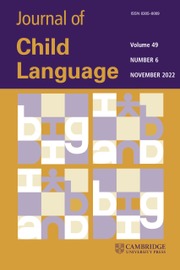Article contents
The influence of linguistic context on young children's understanding of homophonic words
Published online by Cambridge University Press: 17 February 2009
Abstract
This study investigates young children's understanding of homophones in two different linguistic contexts. Research has shown that children interpret homophones according to their ‘primary’ sense even though this is inappropriate to the linguistic context. The present study investigates the influence of different contexts on their interpretations of homophones. A picture test, similar to the British Picture Vocabulary Scale (BPVS), was devised, depicting ten homophones in both their primary and secondary senses. Forty-eight children who were in matched pairs following the BPVS pre-test and whose ages ranged from three to six were asked to select the picture which showed the homophone, first when the homophone was in no linguistic context, and secondly following one of two conditions of the same story which differed according to the richness of context provided. Results showed that those children assigned to story B, the expanded version with full linguistic details and explanations of the words it contained, were more able to identify correctly the secondary meanings of the homophones intended than those children given story A, the unexpanded version. Analyses of variance showed both a significant age trend and a story-type effect. These results are interpreted as showing that the linguistic context is an important factor in young children's understanding of word meaning.
Information
- Type
- Notes and Discussion
- Information
- Copyright
- Copyright © Cambridge University Press 1991
References
REFERENCES
- 16
- Cited by

